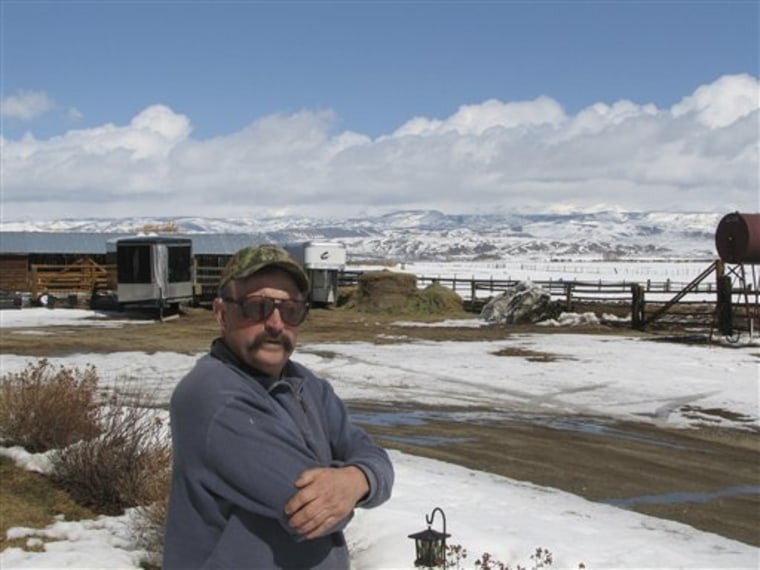There isn't anything metropolitan about this tiny unincorporated town in southwest Wyoming, where a few single-family homes and a volunteer fire station stand against a skyline of snowcapped mountains.
But Boulder, with a population of just 75 people, has one thing in common with major metropolitan areas: air pollution thick enough to pose health risks.
"Used to be you could see horizon to horizon, crystal clear. Now you got this," said Craig Jensen as he gestured to a pale blue sky that he says is not as deeply colored as it used to be. "Makes you wonder what it's going to do to the grass, the trees and the birds."
The pollution, largely from the region's booming natural gas industry, came in the form of ground-level ozone, which has exceeded healthy levels 11 times since January and caused Wyoming to issue its first ozone alerts. Now the ozone threatens to cost the industry and taxpayers millions of dollars to stay within federal clean-air laws.
Huge natural gas reserve
Sublette County is home to one of the largest natural gas reserves in North America, and it is dotted with hundreds of gas wells to supply the nation's growing demand for cleaner-burning fuel. Thousands more wells are planned for the future.
But pollution from vehicles and equipment in the gas fields — along with dust, weather and geography — have raised ozone to a level that rivals those of big cities in the summertime.
Wyoming's ozone problem comes at a time when the federal government has strengthened its ozone restrictions to better protect public health. In March, the Environmental Protection Agency set a new ozone standard of 75 parts per billion, down from 80 parts per billion.
The peak eight-hour average for ozone near Boulder reached 122 parts per billion on Feb. 21 and 102 parts per billion on March 11. By comparison, the Los Angeles area hit a peak average of 152 parts per billion last summer, and Denver recorded a peak of 98 parts per billion last July.
Restrictions could be near
Failure to meet federal air-quality standards could result in mandatory pollution-cutting measures ranging from restricting wood-burning stoves in homes to placing limits on the booming oil and gas industry.
Jeremy Nichols, director of the Denver-based Rocky Mountain Clean Air Action, said all economic development in the region — not just the energy industry — could be affected.
"If we don't get ahead of the curve, we could be suffering serious consequences in the future," Nichols said.
Conservation groups have seized on the ozone alerts in their efforts to curb drilling for natural gas in the area.
"Obviously, the pace and level of development is just too much," said Linda Baker of the Upper Green River Valley Coalition.
The energy industry says it has been working with regulators to ease the problem and insists drilling should not be curtailed.
Severe health risks
Ozone is a component of smog, a yellowish haze of pollutants that lingers near ground level and can raise the risk of asthma and heart attacks, especially among the elderly and children with respiratory illnesses.
Ozone needs sunlight to form, and state environmental officials believe the ozone levels in Wyoming this past winter and spring were exacerbated by heavy snowcover, which intensified the sunlight by reflecting it off the snow. In 2007, when the area had little snowcover, there were no elevated ozone readings.
Also contributing to the situation are rare temperature inversions, when cold air is trapped close to the ground, and the surrounding mountains, which enclose the pollution in the Green River valley.
Gas developers in the area are sharing information on how best to reduce ozone, according to Randy Teeuwan, a spokesman for Encana Corp., one of the largest gas suppliers. Encana already is using natural gas-powered drilling rigs that emit less pollution, and it is consolidating field operations to reduce emissions.
Why wait for the feds?
State officials are working with the industry to reduce emissions without waiting for new federal regulations to take effect.
"We understand that the people who are living up there cannot wait two or three years for us to develop regulatory tools," said David Finley with the state Department of Environmental Quality.
For instance, the state is considering a plan that, when conditions appear ripe for ozone formation, would ask companies to curtail truck traffic or use more drilling rigs powered by cleaner-burning natural gas.
Meanwhile, the Bureau of Land Management is reviewing a proposal by several companies to allow nearly 4,400 more wells in the county.
Jim Sewell, environmental project manager with Shell Exploration and Production, said the expansion project would have lower emissions than existing facilities. The companies also are offering $36 million to pay for environmental monitoring and other measures that lessen the effects of drilling on air quality, wildlife and plants.
Longing for clearer skies
Jensen, whose family has lived in this part of Wyoming for four generations, said he has seen both sides of gas development.
On one hand, he has received royalties from wells on his land, enabling him to buy a boat, snowmobiles and other "toys."
But the pollution leaves Jensen longing for the days of clear skies, little traffic and fewer people.
"I'd give it up right now if all them rigs moved," he said.
